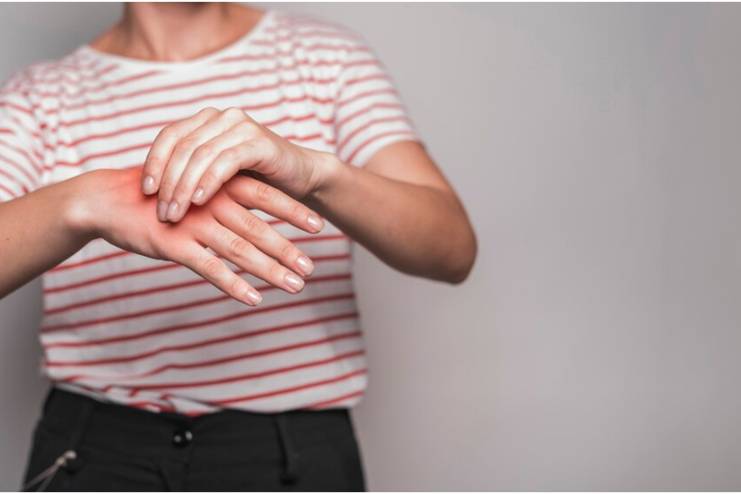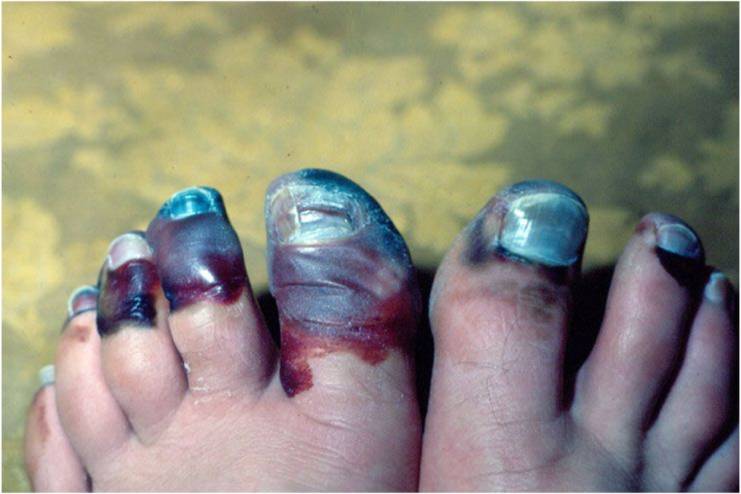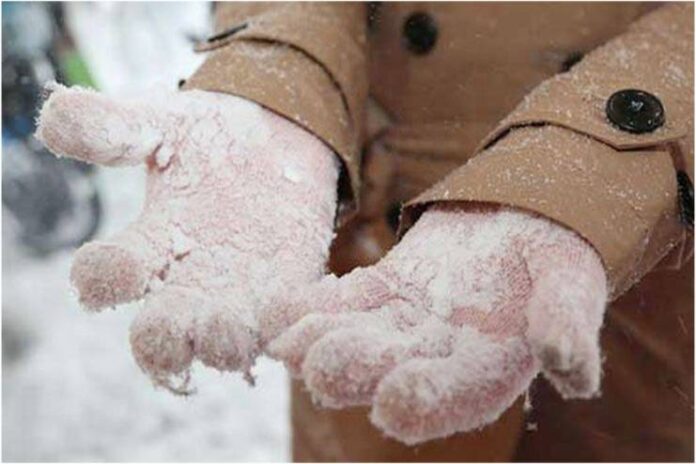Affiliate Disclaimer
Some links in this article are affiliate links. We may earn a small commission if you make a purchase through these links, at no extra cost to you. We only recommend products we find useful to our readersFrostbite occurs when skin is exposed to extreme cold conditions for a long period. This arises due to the freezing of the skin as well as the tissues just under the surface of the skin.
Your skin tends to freeze immediately after being exposed to temperatures below freezing. Even if the temperature is above freezing, the skin can freeze if wet and exposed to severe wind chills.
The development of frostbite may also occur when there is contact between your skin and a cold surface. This results in the immediate freezing of the skin due to the cold temperature of the frozen surface.
The condition can be highly dangerous, as sometimes the freezing of muscles, nerves, and blood vessels may also occur, possibly needing an amputation.
Read on to learn more about frostbite, along with its various symptoms and treatment measures to treat the condition.
What are The Common Symptoms of Frostbite?

The symptoms of frostbite are classified into three major categories. The common symptoms of frostbite that usually appear are listed below:
- The numb or prickly feeling of the skin
- Pain around the affected area
- Discoloration of the skin, such as gray, yellow, white, or red
In severe cases, the symptoms of frostbite are:
- Blackening of the skin
- Development of blisters on the skin
- Stiff joints or muscles
- Difficulty moving muscles
It is important to seek immediate medical help if you are suffering from frostbite, especially if you are experiencing the following symptoms along with the condition:
- Dizziness
- Fever
- Swelling or redness
- Discharge from the affected area
What Are The Causes Of Frostbite?
The major cause of frostbite is prolonged skin exposure to cold temperatures. You may be more susceptible to frostbite in the following situations:
- Absence of appropriate clothing for cold and freezing conditions
- Weakness due to medical conditions such as hunger, dehydration, injury, physical labor, and alcohol consumption
- Smoking, which narrows the blood vessels and causes slow blood circulation
- Diseases such as diabetes, cardiovascular disease, and depression, impair your ability to notice and respond to cold
- Certain medications
It is important to note that older adults and young children are at a higher risk of developing frostbite.
Diagnosing Frostbite

Generally, a physical examination is conducted to diagnose frostbite. Your doctor may also ask for information about your frostbite symptoms. In more severe conditions, your doctor may request X-rays to determine if there has been damage to the muscles or bones.
How to Cure Frostbite – Treatment
If you are experiencing a frostbite and can’t get to a doctor, here are a few things you can do to protect yourself before medical help is avaialble:
- Protect yourself from the cold by seeking shelter
- Tuck your hands under your arms to warm them
- Remove any wet clothing or jewelry and stay inside
- Warm yourself by covering your body with a blanket
- Consume warm drinks if you think you are experiencing dehydration
- Stay away from heat sources such as lamps or heating pads, as these can burn frostbitten skin
- Seek medical help from an expert as soon as possible
The preferred way of treating frostbite is by gently and gradually warming the affected area with warm water. Your doctor may also wrap the affected area after sterilizing it. Frostbite can cause the skin to become raw, making your skin more susceptible to infections. If your skin is infected, your doctor may prescribe antibiotics.
Your doctor may help repair the damaged tissues with drugs known as thrombolytics, which will be administered intravenously. Although these drugs may cause severe bleeding, they are considered a last resort to prevent amputation.
In extreme cases of frostbite, damage can occur to the muscles, bones, and nerves. To treat this, your doctor may suggest amputation surgery.
How to Prevent Frostbites
The most important thing to do to prevent frostbite is to dress appropriately for cold weather. Keep yourself informed about the weather before stepping outside. When the weather is freezing, and the temperature is below the freezing point, it is recommended not to stay outside for a long time.
Wearing multiple layers of clothing while venturing out in cold weather is advisable. It is also important to ensure that no part of the skin is exposed and that your clothing is waterproof and loose-fitting.
In situations where you cannot anticipate the risk of frostbite, it is helpful to keep an emergency kit with you at all times when stepping outside, especially in cold weather. The kit should contain important items such as gloves, blankets, hats, and some non-perishable snacks.
Complications of Frostbite

- Hypothermia: Frostbite can dangerously lower body temperature. Hypothermia is a medical emergency because of its potentially fatal nature.
- Increased Sensitivity to Cold: Survivors of frostbite often experience enhanced sensitivity to cold in the affected areas and increased susceptibility to further episodes of frostbite.
- Neuropathy: Frostbite can cause neuropathy or long-term nerve damage. For an extended period, the area becomes numb and cannot feel sensations. This increases the risk of further damage since the individual would not feel the pain or temperature changes in that affected area.
- Excessive Sweating (Hyperhidrosis): There can be excessive sweating in the area of frostbite. This may result in pain and hinder one’s ability to regulate his or her body temperature over the area.
- Changes in the Nail and Its Loss: The nails get affected due to frostbite and can change in shape, color, or texture. It might also cause a complete loss of the nail. In many cases, the loss might be permanent, or in some, it leads to abnormal growth of the nails.
- Frostbite Arthritis: Severe frostbite can damage the joints. This will make the affected areas, especially hands and feet, stiff and painful. Sometimes, it is referred to as frostbite arthritis, which may limit movement and lead to chronic pain in the joint.
- Skin Discoloration and Scarring: Skin discoloration and scarring might also occur from frostbite. The marks may be caused by tissue damage and are permanent on the affected region or from pigmentation changes.
- Growth Problems in Children: Frostbite in children can damage the growth plates of bones, affecting bone development and growth.
- Infection and Tetanus: The tissue will become susceptible to infection. This may increase the difficulty in recovery and also lead to more tissue damage. The risk for tetanus is increased as well by frostbite. Vaccination or booster shots are advisable.
- Gangrene and Amputation: Where frostbite leads to major tissue necrosis, gangrene may result, and amputation may be necessary to protect the remaining healthy tissue and prevent infection from spreading. Gangrene is one of the most serious complications of frostbite and is always associated with considerable tissue loss.
- Damage to Deeper Structures: This includes the muscles, tendons, and bones. In more severe frostbite, damage is not limited to the skin but also includes the deeper structures, including muscles, tendons, or even bones. This can lead to chronic pain or loss of function and would sometimes require surgical intervention.
Conclusion
Frostbite is a serious condition that arises from prolonged exposure to extreme cold, leading to the freezing of skin and underlying tissues. Recognizing the symptoms early, such as numbness, discoloration, and severe pain, is crucial for prompt treatment. Immediate medical attention is essential, especially in severe cases where blisters and tissue damage occur.
Prevention is key; dressing appropriately for cold weather and being aware of environmental conditions can significantly reduce the risk of frostbite. In this potentially life-threatening condition, understanding its causes, symptoms, and effective treatment options is vital for safeguarding your health and well-being during colder months. Always prioritize safety by preparing for adverse weather conditions and seeking help at the first signs of frostbite.
-
Oct 2017Written by Prajakt
-
Nov 2024Edited by Lakshmi Gayatri
In this Article















